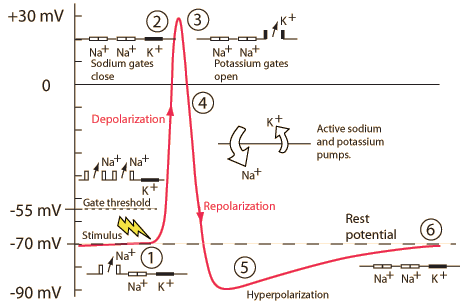Action Potential
Action potential is the energy that travels from one neuron to another neuron. Everything that we do is due to electrochemical changes taking place in our brains. For example, if a person hears a noise while taking a test and looks up, this means that the noise was strong enough to generate an action potential. The stimulus needs to be strong enough in order to trigger an action potential. If the stimulus isn't strong enough (i.e. below threshold), then no action potential would be generated. This is the all or nothing phenomenon. Once the action potentials are generated, they will fire with the same amount of magnitude regardless of the stimulus.


Stages of Action Potential
Positive peak: At the occurrence of a positive peak, the sodium gate will close due to the neuron being too positive. It will then allow the potassium to go inside of the neuron in order to make it slowly become negative.
Resting potential: At this stage the potassium gates open. There are only a few potassium molecules that move in and out of the neuron.
Depolarizing and threshold: At this stage few sodium gates open and move into the neuron, gradually increasing the potential inside the cell. The potential inside the cell is becoming positive.
Depolarization/rising phase: In this stage the sodium gates open allowing sodium to move in which causes the neuron to become more positive.
Falling phase/repolarizing: Intake of sodium ions would cause the inside of the membrane to become more positive; the drop in voltage that occurs during falling phase is due to potassium ions flowing out of the cell.
Hyperpolarization: Many of the sodium gates close and many potassium molecules leave the neuron. The inside begins to become more negative than it was at the resting stage.
Recovery: The potassium gates come to a close and the neuron goes back to the resting phase.

A helpful metaphor to better understand this important concept!

Action Potential inside the White House
Reporters Na+ (sodium)
Security K+ (potassium)
White House (neuron)
The White House is full of security (K+) at all times and as usual reporters (Na+) are constantly trying to come into the gate (resting phase). The reporters (Na+) are finally allowed access by security (K+) (depolarizing). When the reporters (Na+) are in the White House, this causes the White House to be more positive (depolarized). Once the reporters (Na+) enter the White House, security (K+) then realizes that there are too many reporters (Na+) inside the White House causing chaos (negative energy), so security (K+) has to escort some reporters (Na+) out to equalize the balance (repolarizing). Security (K+) escorts the reporters (Na+) out of the White House. Security (K+) then realizes that there is not enough backup (energy) at the gate, so they have to go back in to equalize it. Since there is more security (K+) outside and less reporters (Na+) inside, this will cause the White House to become a frenzy (hyperpolarized). Security (K+) returns back to the White House with reporters (Na+) outside the gate, once again, returning it to its orginal state (resting phase).
